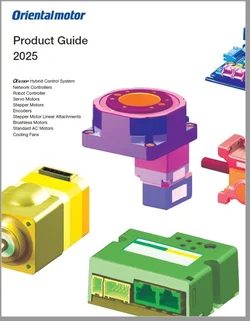Motors exhibit noise. The important thing to know is how you distinguish normal noise from abnormal noise, and how to troubleshoot.
Similar to a baby, a motor doesn't tell you when it's having problems or what you need to do, but the sound that a motor makes can tell you a lot.
If a motor produces abnormal noise, the possible causes can be:
- Backlash
- Gears
- Excessive vibration
- Motor Damage
- Gearhead Damage
This article provides more information on these types of noises and what can be done to minimize the noise. It's important to remember to isolate the motor from any other noise-making source, such as metal plates or loose bolts. It's also very useful to have an extra motor in good working condition for noise comparison, so you have a reference point.
For more information, please read on.
Backlash
Noise can be exhibited by geared motors as the surface of gears inside the gearhead continuously collides with each other during rotation. There's a chance for gear collision because of backlash, which is any space between the gear teeth. This sounds like a consistent "hum", and the noise can differ from different types of gears. This noise doesn't mean there's a malfunction and does not affect the motor characteristics or the life of the gearhead.
We show a spur gear example here with backlash.
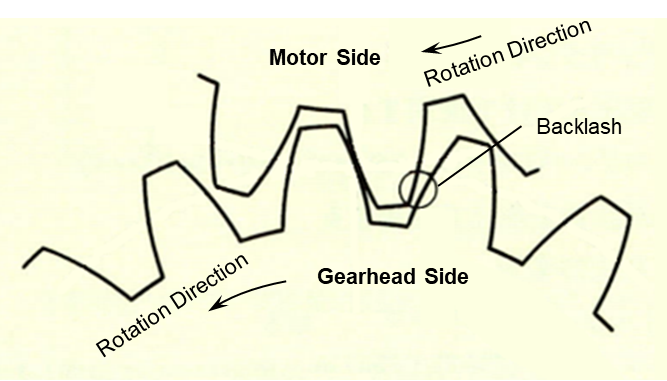
There are cases where this backlash noise is amplified, such as when the load is removed from the motor, or when a motor is oversized. For an AC motor, as the load becomes lighter than its rated load, it's no longer operating at its optimal efficiency point, therefore more vibration is exhibited, which becomes noise. Also, when the motor reverses direction, the backlash could make a different type of impact noise between gears. Brushless motors and stepper motors do not have this problem since the power is regulated by the driver.
How to verify?
Typically, this noise is louder from an unloaded or oversized motor. If the motor is unloaded, lightly apply a frictional load to the gearhead output shaft. If the noise is suppressed by applying a friction load, then this noise is normal. If increasing the load on the motor does not have an effect or increases the noise, or if the noise is not consistent, then the noise is caused by something else.
To lower the impact sound in bi-directional applications, helical gears or higher quality gears with more contact surface area are recommended. For the best performance, a motor sizing consultation should include the selection of the motor as well as the type of gears.
| FYI |
|
AC motors work best with their rated load since all mechanical and electrical specifications were designed for the rated load. An unloaded motor exhibits more noise than a motor with a rated load. For brushless motors, oversizing is not a huge issue since the motor only uses as much current as the load requires. For stepper motors, even if the motor is oversized, the current setting can be reduced to lower torque, which helps minimize excessive vibration. |
Gears
For geared motors, since gears are always meshing with other gears, any damage or scratch on the surface of teeth inside the gearhead can cause another type of abnormal noise during rotation. If you notice an increased level of noise after assembling or disassembling the motor and gearhead, it could mean that the gear teeth were damaged or scratched.

To keep the geared motor design compact, Oriental Motor does not use a coupling between the motor shaft and gearhead. Instead, we machine the motor shaft into a pinion shaft, then use that shaft to mate with the internal gears in the gearhead directly as shown below (motor shaft is on the right side).

Since we mate the motor's pinion shaft with the gears directly, any scratch or damage on the surface of the pinion shaft will cause additional noise to be exhibited. The good news is that the motor's characteristics are not affected; although there's no easy way to correct this issue.
How to verify?
If the noise level is much higher when the motor and gearhead are assembled versus just the motor, this means you may have some damage or scratches on the surface of your gear teeth. Unfortunately, there's no way to correct this besides replacing the gearhead.
If a periodic sound is heard periodically at specific intervals, then it's possible to estimate which gear tooth and which side of the tooth is damaged. Oriental Motor can provide a product inspection to confirm teeth damage, but there's not much else we can do.
| FYI |
| Be careful when assembling or disassembling gearheads from motors with a pinion shaft to prevent damage to the surface of internal gears. Follow the installation instructions in the manual. If you do not want to assemble them yourself, please ask for pre-assembled options. |
Excessive Vibration
Vibration is a component of noise. One thing that can increase vibration from a motor is incorrect connection or power supply voltage. Higher voltage increases torque but excessive torque can increase noise. Higher or lower voltage also alters a motor's speed torque curve and operating temperature. Vibration can also be amplified through other means, such as loose bolts and/or metal plates. When troubleshooting noise, it's important to isolate all other vibrations.
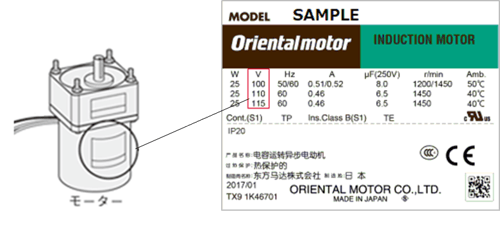
How to verify?
Verify the wiring between the power supply, the capacitor, and the motor, and check if the input voltage is within +/-10% of the motor's specifications. Also, check if the right capacitor is connected between the power supply and the motor. The voltage and capacitance of the dedicated capacitor are essential components in determining the speed torque curve, rated torque, and the magnetic balance of the motor. If the wrong voltage or capacitance is used, it can mess with the efficiency of the motor and increase its vibration.
Here we show how a voltage tester can be used.
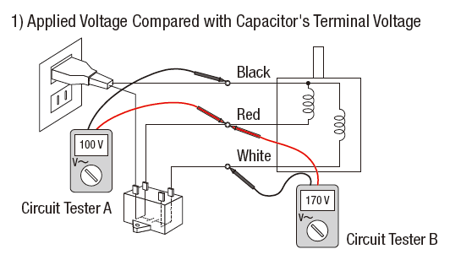
A voltage approximately 1.4 to 1.7 times higher than the power supply voltage is applied between the capacitor pins. The rated voltage of the capacitor is different from the rated voltage of the motor. For example, when the motor's rated voltage is 100 VAC, the rated voltage of the capacitor can be 250 VAC or more.
The capacitance specification is listed on the motor label and capacitor (as well as on our website, catalogs, and brochures). In the example below, we show a single-phase 100 VAC induction motor with an 8 microfarad capacitor. The same motor also operates at 115 VAC with a 6.5 microfarad capacitor. The rated voltage of the capacitor is 250 VAC.
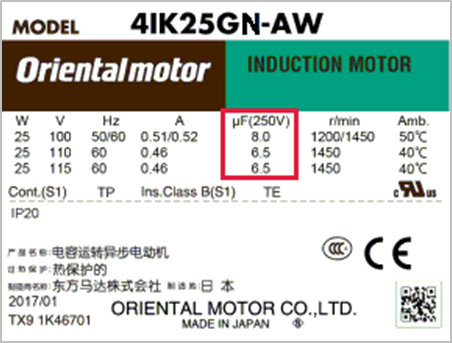
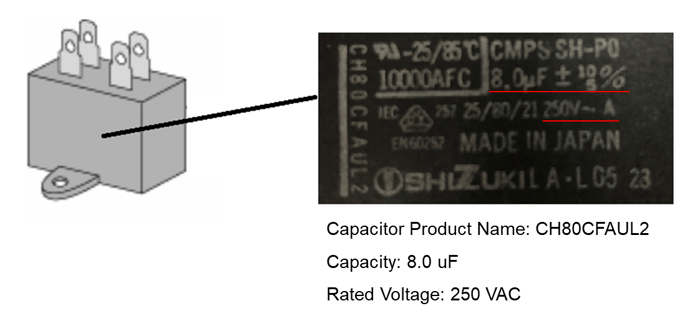
| FYI |
|
For AC motors; Make sure to provide the proper input voltage to the motor within +/-10% of the specification. The torque changes as the power supply voltage fluctuate. The torque generated by the motor is approximately proportional to the square of the input voltage.
A low input voltage may result in insufficient torque. A higher input voltage may result in higher torque but also higher temperature and vibration. For brushless motors: The drivers regulate the voltage and current to the motor according to the load, so excessive vibration is minimized. For stepper motors: If there's too much excessive vibration due to too much torque, reduce the driver's motor current setting or use a smaller motor. A motor sizing consultation is recommended. |
Motor Damage
If the motor shaft makes a noise while the gearhead is removed, then there's something wrong with the motor. For example, the motor bearing may be damaged by excessive load. Sometimes, motor damage can occur from mishandling, such as dropping the motor.
How to verify?
Disconnect the motor from power and load. Visually check the pinion shaft surface for damage, and check if there's any noise when the motor shaft is rotated forward or reverse by hand. If you cannot even rotate the motor shaft a whole revolution, then it means the bearings could be damaged. For motors with an electromagnetic brake, please make sure the electromagnetic brake is released before testing. Some pre-assembled motors, such as stepper motors, cannot be taken apart. Please replace these motors.
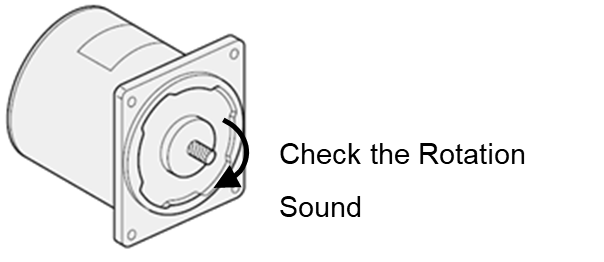
| FYI |
|
If you cannot manually rotate the motor's pinion shaft clockwise and counter-clockwise, or if it makes an abnormal noise when doing so, then it means that the motor bearing is damaged. Since our motor case is designed not to be taken apart, there's no easy way to correct bearing issues. Please purchase a new motor and determine prevention measures. |
Gearhead Damage
If the gearhead is making noise without the motor, it's likely that the gearhead is damaged. This could be the gearhead case, bearings, or gears. This is actually very difficult to troubleshoot without a reference point of normal noise and accurate noise measurement.
How to verify?
Similar to the last motor bearing test, remove the gearhead from the motor and then visually inspect the gears. When the gearhead is removed from the motor, some of the internal gears are visible. You can try to rotate the gearhead shaft in order to inspect more gears. If you shake the gearhead, nothing should sound "loose". Also, try to rotate the gearhead shaft forward and backward by hand. This could be difficult to do depending on size and gear ratio.
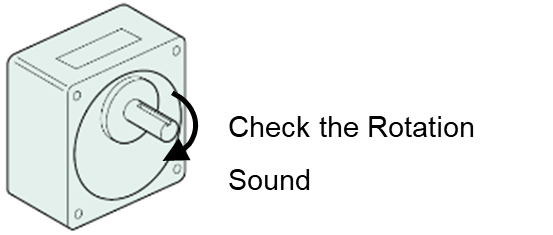
| FYI |
| If the gearhead makes an inconsistent cyclical noise or if you cannot turn the output shaft manually, it means either a certain set of gears or the bearings are damaged. Please replace the gearhead. |
That's it for now, folks. Of course, the easiest way to fix these problems is to replace the motor and/or gearhead. A better way is to prevent these issues by performing a motor sizing analysis. This article provides a deeper understanding of motor noise for anyone who wishes to learn more (and hopefully prevent the same issue from happening again).
You're welcome to call, e-mail, or chat with our technical support engineers for more information.
FAQs
|
Q: I purchased the same motor and gearhead as before, but compared with the motors I used to use, the noise during operation is louder. What are the probable causes? |
|
A: The probable causes can be: (1) The backlash sound of his gearhead with changing load conditions varies with load conditions. For example, when there is no load, the gears bounce during rotation, and the gears continuously collide with each other as they rotate, causing vibration and noise. This sound can be suppressed by adding a friction load. Check the load condition and the fixing method to the mounting surface. When assembling the motor and gear head, or due to fatigue of the internal gears due to overloading, the teeth may be scratched and noise may be generated when the motor rotates. When assembling, use the spigot parts as guides so as not to damage the teeth, and turn the gearhead gently left and right so that the toothed part of the shaft does not hit the side plate of the gearhead or the gears. |
| Q: How do I replace a gearhead of a combination type (pre-assembled geared motor)? |
|
A: Please follow the instructions in the manual for disassembly and assembly, including tightening torque. ・Do not forcibly assemble the motor and gearhead, or put foreign objects such as metal pieces inside the gearhead. Doing so may damage the pinion or gear of the motor output shaft, resulting in abnormal noise or shortened service life. ・Do not let dust adhere to the spigot of the motor and gearhead. Also, be careful not to get the O-ring on the spigot of the motor caught. Doing so may cause grease to leak from inside the gearhead. ・The hexagon socket head bolts that assemble the motor and gearhead are for fixing the motor and gearhead. Be sure to use the included hexagon socket head bolt set for installation. |
| Q: How do I check if specific motors and gearheads can be combined? |
| A: You can check the part number description, or look through compatible gearheads. You can always ask our technical support engineers for quick tips. |
| Q: Is there a way to check if the AC motor is broken? |
| A: Yes, there are three ways.
1. Checking the winding state by measuring the motor winding resistance <Caution> ・Before checking, be sure to turn off the power to prevent electric shock and short circuits.・If the breaker trips when power is applied, the motor power line may have a ground fault or the motor may have insulation breakdown. It is recommended to replace the motor capacitor without turning on the power. |
Disclaimer: This article provides troubleshooting tips, but only qualified professionals should perform the work. If you're not qualified, please contact our technical support team. Oriental Motor is not liable for any injuries that can potentially happen from performing the work.


